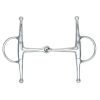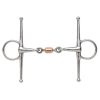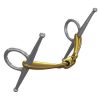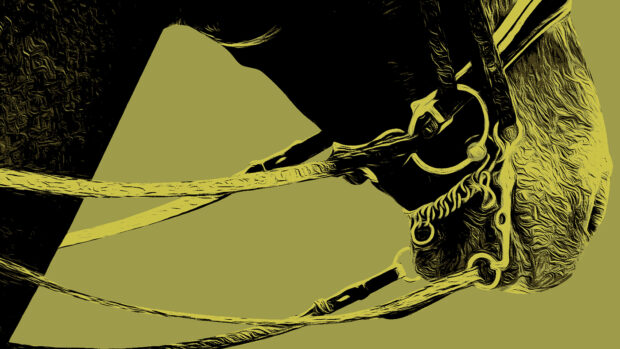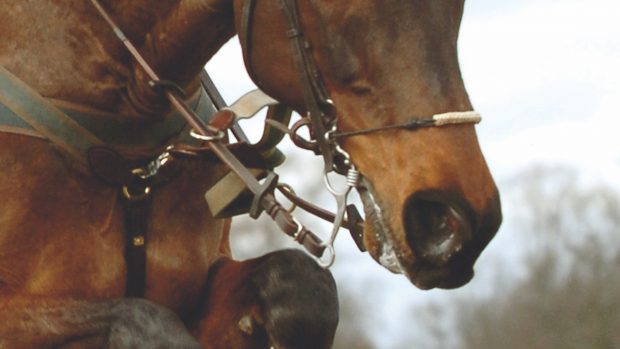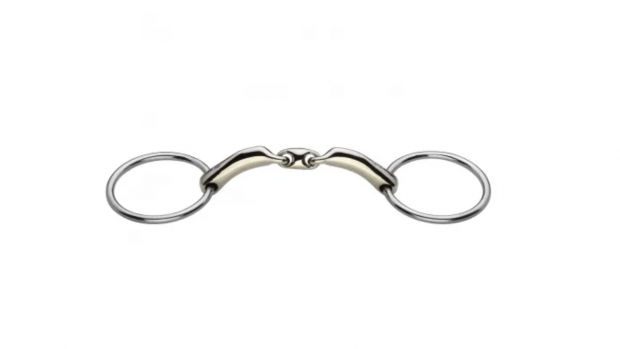What is a full cheek snaffle?
The full cheek snaffle has long bars attached to the bit rings, which provide lateral pressure on the horse’s mouth and the side of the head as well as preventing the bit from sliding through the mouth. This can help encourage the horse to turn.
This cheekpiece is ideal for horses that are starting out or for those that are having difficulty learning what rein pressure means, and for those that avoid the contact by opening their mouths as the long bars prevent the bit from moving excessively from side to side.
This is a bit from the snaffle category of bitting as it has a direct line of contact from the bit, through the reins to the rider’s hands. This is because the rein is attached level with the bit’s mouthpiece and not below it. There is no lever, curb, poll pressure or other action beyond a direct line of contact from the rider’s hands through the reins to the bit.
Bitting expert, BETA field officer and lorinery consultant Tricia Nassau-Williams says: “Being a snaffle, it will employ pressure points upon the horse’s lips, bars and tongue – as the rein contact is taken up, it will encourage an upwards action. The mouthpiece should not act upon the roof of the mouth and care must be taken to see that it is correctly sized and fitted.
“Generally a horse will react to a snaffle bit by lifting his head and neck. The exact contact across the mouth will vary depending upon the mouthpiece’s design, and the horse’s level of training, as well as his fitness and consequently the position in which he holds himself (his head, neck and forehand etc.). The fixed design of the bits cheeks provides less movement or ‘play’ of the mouthpiece when compared to that of a loose ring. It also has the advantage of being less likely to pinch the lips.”
Tricia highlights that the full cheek snaffle and Fulmer snaffle (pictured directly below) are often confused with each other.
“A Fulmer snaffle is not the same as a full cheek snaffle – the two often get muddled.”

A Fulmer snaffle – not a full cheek snaffle
How does a full cheek snaffle work?

The cheeks extend both above and below the mouthpiece and have no action upon the mechanics of the bit. The top cheeks uppermost ends are slightly turned away (outwards) at the tops. This is to help prevent them from pushing into the horse’s face.
“Consequently, it is critical to take time when fitting the bit onto the bridle to make sure that it has been attached onto the bridle the correct way up,” says Tricia.
“The long cheek’s function is to prevent the bit from being pulled through the mouth and to help keep the mouthpiece central. Additionally, the long cheeks provide a generous amount of directional support to the rein aids. Leather Fulmer loops (found here on Viovet) can be fitted to attach the bit to the bridle at the top of the bits upper cheeks to prevent the bit from rotating forwards. However, this is not as imperative on a full cheek snaffle as it would be for a Fulmer snaffle, which is similar in appearance but has loose rings.”
Full cheek snaffles are available in a wide range of mouthpieces to meet the individual requirements of each horse.
“Types of full cheek snaffle mouthpieces include a lozenge, straight bar, single jointed, Waterford, turtle top, barrel and the now less popular French link, to name a few,” says Tricia. “Seek help and advice from a qualified bit and bridle fitter if you are not sure what will best suit your horse’s individual mouth conformation and type.”
Due to the long sides, there is a risk of the bit becoming tangled in the reins or mouth and nostrils. Care should be taken when using this cheekpiece to ensure the horse does not get themselves caught on any objects. Fulmer keepers can be used to ensure the bit remains in a fixed position and away from the lips and nostrils.

Shires Full Cheek French Link Snaffle at viovet.co.uk
The French link in this bit means pressure is applied to both sides of the tongue. Some horses with low palates may find this bit more comfortable as it’s unlikely to make contact with the palate when the bit comes in to action.

Shires Sweet Iron Full Cheek Snaffle at viovet.co.uk
The sweet iron mouthpiece of this full cheek snaffle bit produces a pleasant taste and encourages the horse to soften and salivate. The raised copper ribs can help to prevent the horse taking too much of a hold. Also available with copper lozenge.
Which types of horse does this bit suit best?
Tricia says that this bit can be useful for “novice riders or novice horses, also when lungeing and long reining”.
“The cheeks that extend both above and below the mouthpiece provide guidance and support to the rider’s aids. This can be very helpful for a green horse that is in the early stages of his training,” explains Tricia. “The long cheeks also help to keep the bit’s mouthpiece central and prevents it from sliding through or being pulled across the mouth. This can be useful for a horse or pony when being ridden by a less experienced rider. It is also useful for a novice horse or one in faster work where the lateral contact against the side of the face aids directional guidance.”

Shires Soft Rubber Covered Full Cheek Snaffle at viovet.co.uk
The soft rubber mouthpiece of this full cheek snaffle provides a thick and therefore mild surface for the horse to learn to accept a contact – ideal for young horses.

Shires EquiKind Mullen Full Cheek Snaffle at viovet.co.uk
This tasty apple flavoured EquiKind mouth bit has full cheeks to help with steering. The EquiKind mouthpiece is lighter and more flexible, and particularly suitable for young, sensitive horses.
You might also like:
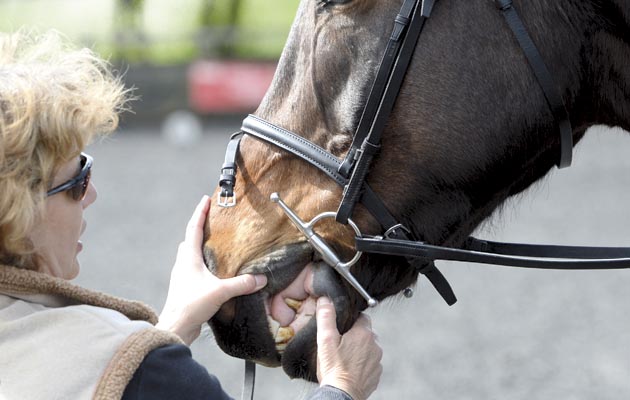
5 top tips to help you choose the perfect bit for your horse

Does your bit fit? How to measure your horse’s mouth size

Choosing the right bit for your horse

Subscribe to Horse & Hound magazine today – and enjoy unlimited website access all year round
Horse & Hound magazine, out every Thursday, is packed with all the latest news and reports, as well as interviews, specials, nostalgia, vet and training advice. Find how you can enjoy the magazine delivered to your door every week, plus options to upgrade your subscription to access our online service that brings you breaking news and reports as well as other benefits.


